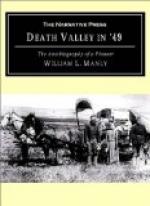From Santa Cruz I crossed the mountain on a lonely and romantic trail to San Jose again, finding very few houses on the road. Here I went to work for R. G. Moody building a gristmill on the banks of the Coyote Creek, to be run by water from artesian wells. When the mill was done I went for my horse, and on my return I ran very unexpectedly upon Davenport Helms, to whom I had sold my little black mule in 1850. Our talk was short but he told me he had killed a man in Georgetown, and the sheriff was looking for him. He was now venturing to town for tobacco, and would hurry back to the hills again where he was herding cattle.
He said he kept them off at one time by getting in a piece of chaparral and presenting his gun to them when they came near, they dare not advance on him. Then he laughed and said—“And all the time my gun was empty, for I did not have a d——d thing to put into it.” “I tell you they don’t catch old Davenport. Now don’t you tell on me. Good-bye.” I saw him no more after that.
The town of San Jose was now more of a town than it was a few years before. The “Forty Thieves,” and others, commenced building a city hall of brick on the top of old adobe walls, and this was the principal improvement, except the Moody mill near the Sutter house, one street north of Julian.
After finishing work on the mill I drew my money from the bank in San Francisco and started for the mines on horseback. Near French Camp, on the east side of the San Joaquin Valley, many cattle were feeding on the plains, and among them, much to my surprise I found “Old Crump,” the ox that brought Bennett’s and Arcane’s children safe through from Death Valley in February, 1850. He was now fat and sleek and as kind and gentle as when so poor upon the terrible journey. I got off my horse and went up to him, and patted my old friend. I was glad to find him so contented and happy, and I doubt not that he too was glad. I met a man near by and asked him about the ox, and he said that the owner would not sell him nor allow him to be worked, for he knew of the faithful part he performed in the world, and respected him for it.
At Sacramento I deposited my money with Page, Bacon & Co., a branch of the St. Louis firm of the same name, considered the safest bank in the United States. Their bills were taken in payment of Government land. Some rascals had some counterfeit bills on their bank, and traded them off for gold with the Missourians who were going home, and the poor fellows found themselves poor on arrival.
Going to my mine, where I left only a cabin or two, I found quite a village with two hotels and a post office.




